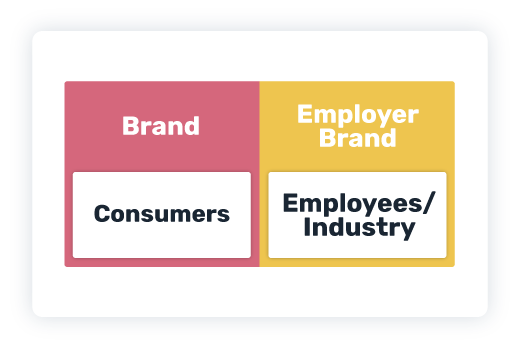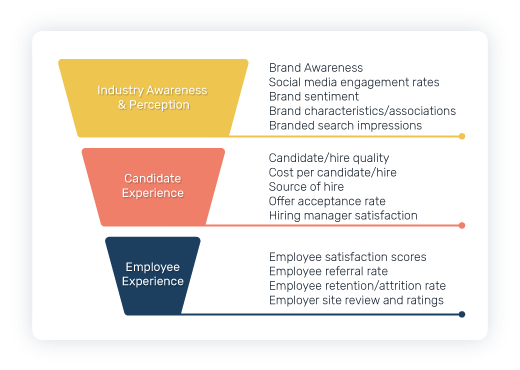A strong employer brand is key to recruiting today’s top talent. But how do you measure an employer brand and what metrics should you be using if you want to grow fast?
"When you're thinking about your metrics, try to pick the one goal that helps you reach your biggest business objective, and let the other stuff be more health indicators than main drivers. For us, overall, it's going to be qualified applicants. And that's going to be our one goal or metric."
Sean Bestor, Whole Foods
Today, you’ll learn how to measure your employer branding efforts and which key performance indicators (KPIs) to select based on your specific tactics. We’ll also look at a ton of different metrics that you should consider as a part of your program.
Plus, we’ve got special guest Sean Bestor from Whole Foods to help us understand the difference between vanity metrics and the numbers that truly matter to successful employer brands.
Stay tuned.... (but download our Employer Branding Metrics Checklist first.)
What Is an Employer Brand and Why Should I Measure It?
First, let’s briefly cover what an employer brand is and why you should measure it.
Much like how consumer brands are the combined feelings, thoughts, and emotions that a person has for a product or service that a company offers, an employer brand is the overall impression that company makes on its current employees, prospective hires, and people that work in the industry.

The employer branding space is really heating up, especially in competitive hiring spaces like technology, product, and growth marketing. Tactics range from team-wide social media trainings all the way up to using 1:1 personalized marketing experiences when recruiting for key positions within the company.
And at the heart of any good employer branding program is a measurement strategy–you can’t improve what you’re not measuring.
Let’s take a look at some common employer branding tactics and how to measure them.
How to Measure Employer Brand
For starters, this wouldn’t be a proper tutorial about marketing measurement without the use of a funnel analogy.
Much like building consumer brands, the employer branding process also has a top, middle, and bottom of the funnel:
- Top of funnel—Industry Awareness & Perception
- Middle of funnel—Candidate Experience
- Bottom of funnel—Employee Experience

But before we get into each section, let’s make a quick distinction.
When we say the word “metric”, we mean any number that you can calculate to support your business goals.
When we say, “key performance indicator” or “KPI”, we are talking about the one or two very special metrics that should drive our business decisions in a particular area.
All KPIs are metrics, but not all metrics are KPIs.
Now, let’s look at what metrics you should consider using to measure your employer brand.
1) Measuring Industry Awareness & Perception
The first step in building any employer brand is to grow awareness and positive perceptions of the company within the industry.
The goal at this stage is to understand a) how many people know about the brand and b) what do they think about it? Measurement at this stage is intuitive, although not always straightforward to achieve.
The most common top-of-funnel employer branding metrics are:
- Brand awareness*
- Social media engagement rates*
- Brand sentiment
- Brand characteristics/associations
- Branded search impressions
*Suggested KPI
Calculating brand awareness is typically done through proxy metrics like social media mentions, search volume, or website rankings, but ideally you want to determine awareness by conducting longitudinal surveys within your target industry over time.
Social media engagement is a good metric to watch at this stage as well. Calculating the relative engagement rates between your company and its competitors will help you track which brand has the largest share of voice.
And here again, it’s always helpful to have those ongoing industry studies to help determine how things like brand sentiment and associations are changing over time.
2) Measuring Candidate Experience
Ok, someone in the industry knows about your brand and has developed a favorable enough opinion to apply for an opening at the company.
The next step in any employer branding measurement program is the candidate experience.
At this stage, it’s all about the recruitment pipeline and metrics to support it.
The most common mid-funnel employer branding metrics are:
- Candidate/hire quality*
- Cost per candidate/hire*
- Source of hire
- Offer acceptance rate
- Hiring manager satisfaction
*Suggested KPI
Calculating these metrics are mostly straightforward.
Most applicant tracking software these days allows teams to include metadata about candidates that include quality ratings, channel sources, and satisfaction rates among the interview and hiring teams.
When it comes to cost and source of hire, you’re probably going to have to maintain a spreadsheet somewhere to keep track of recruiting-related advertising campaigns and their resulting impact on recruiting efforts.
Ideally, you’ll also want to segment things here as best you can so you can see the differences between your efforts across job roles, departments, and advertising channels.
3) Measuring Employee Experience
The last step in creating an employer brand measurement strategy is to select metrics to support the bottom of the employer branding funnel, the employee experience.
At this stage, you’re looking to track how your employees feel about the company, measured both internally and externally.
The most common bottom-funnel employer branding metrics are:
- Employee satisfaction scores*
- Employee referral rate
- Employee retention/attrition rates
- Employer site review and ratings
*Suggested KPI
There are many different ways to calculate employee satisfaction internally that range from simple emails, surveys, and spreadsheets to SaaS-based employee engagement tools like TinyPulse, Culture Amp, or Lattice.
Externally, every industry is going to have its own trusted third party when it comes to employer reviews. Glassdoor is a popular site among many marketing, startup, and tech professionals, for example.
And while these sites aren’t always the most accurate or reliable ways to measure employee satisfaction, they shouldn’t be ignored given how much visibility and klout they can have in an industry.
An Employer Brand Measurement Case Study
Now that we have a good idea of how to measure employer brands, let’s take a look at a real life example.
For that, today Sean Bestor joins us on Growing Brands. Sean is the Team Lead of Global Employer Brand Marketing at Whole Foods. We had a chance to ask him about his team’s KPIs and metrics and how they went about choosing them.
Watch the interview to hear Sean answer these questions:
- What’s a good process for picking your employer branding metrics?
- What are the most important metrics or key performance indicators?
- What are some vanity metrics to avoid when it comes to employer branding and in what ways can they be gamed to provide an inaccurate picture of what’s going on?
Employer Brand Measurement, in Closing
If you liked this episode then take a few seconds to subscribe download our employer branding metric checklist (scroll up) or subscribe to our newsletter which contains exclusive brand measurement and growth marketing tips that I don’t share anywhere else.
Ok, you’re up…
How do you measure your employer brand? What metrics do you use at each stage of the funnel and what special metrics do you reserve for your key performance indicators?
Let me know by leaving a comment real quick before you leave.
Transcript from our interview with Sean Bestor:
So what's a good process for picking your employer branding metrics? So one of the things that I wanna acknowledge off the top two is to, whoever's watching this, if you're in this space, the majority of people are either one person team or a small team or really been predominantly HR recruiting and you're doing this on the side to help your company. So really there are very few companies that actually have those out teams with big enough budgets to measure this stuff effectively. So that's more the exception not the norm. So don't beat yourself up if you have these crazy high expectations because now this space still isn't as developed as true growth marketing teams are. With that said, I really like this question because what I know from marketing back in my days in SAS, is everybody's playbook is a little bit different. So the output might be different for you, which is why I'll talk a bit broadly here. So for my team, and I think this is very replicable and no matter what size you are or how many people you have on your team, we pick one metric and then everything else is a health goal of strategy. So the reason that we do this is because it gives us more room to think about the process instead of the outcome. So if you have like a bunch of different main metrics, most likely you're going to be splitting off most of your time and then oftentimes your overall outcomes not gonna be super clear. So identifying one main metric to go after, you're gonna gain focus and clarity right into where you're going. So for us, everything cascades down from one goal and then we split it into two sections, Organic Branding and Direct Response. And we do that because it's a lot easier to back up your efforts into these two areas, which means you don't have to chase as many metrics or goals. So, then those two brackets have health metrics that we'll check. But it's not anything that we'll obsess over because we're at the end of the day we're looking at that one goal. So when you're thinking about your metrics, try to pick the one goal that helps you reach your biggest business objective. And let the other stuff be more of health indicators than main drivers. Sure. So that way you don't get distracted by all the little things going on. You've got kind of like a North star and that's kind of leading you to the right a path there. So. Great. So what are some of the most important metrics? Or some of your key performance indicators that you're using now that you've mentioned it? Sure. So for us overall it's gonna be qualified applicants and that's gonna be our one goal or metric. And it can be both applied in the short term campaign or as a long measure of focus. So if you think about it, if you're running a month long campaign, you can easily check how many qualified applicants you've driven. And then year over year you can see if you're increasing your qualified applicants. And the overall goal of effective career branding in our opinion, should be to hire better people faster. And so for us, this is why I mentioned everyone has different playbooks. We get about 1.5 million applications per year at Whole Foods. So we need to not necessarily add more applicants. We don't need to add more applications. Rather we need to identify and drive like a qualified candidate into the pipeline. So when your goal is to drive a qualified candidate, it gives a lot of clarity and option to what marketing playbook you roll out. One other one that we end up using is time to hire, which again is shoulder long, but we use it as long as it relates to real branding. So if you think a lot about the branding work that you do, sometimes you're in a smaller team, it's really tough to measure everything outside of maybe engagements or likes or followers or whatever it may be. The reason that I like time to hire for branding is because if you're telling the right stories and you're reaching the right people, eventually for some of these tough to fill roles or these new roles that you're opening in certain areas like marketing or tech or whatever it may be, you're gonna find that your time to hire goes down a little bit more. If you're doing this correctly because more people are gonna be seeing your stories and captivated by it. So I like that one for branding and then for that branding area, again, it's more on the tactical area. It's usually gonna be also overall engagement too. Like I mentioned, this doesn't have to be a massive thing where you're hyper analyzing things. Especially when it comes to daily social posts. It's more like one of those metrics you get to fill for over time where you say your baseline might be 85 likes and comments on a post. You'll see if one type of piece of content will consistently either be a below or above them and you can make actions based on that, so those are really the big ones for us. It's gonna be the qualified applicant, it's gonna be the main goal. We have time to hire for branding and then we can also look at overall engagement, but really the big one and our one goal is gonna be your qualified applicants. Those are excellent philosophies and tactics for employer branding and how to measure it. Sean Bestor. Thank you so much for your time. Of course. Thank you Josh.


